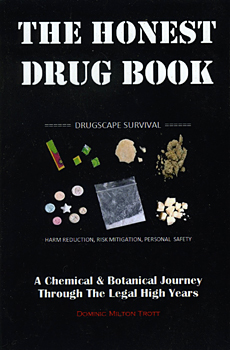
In the mid-90s, a term emerged to describe the scientific or semi-scientific usage of reporting on one’s own usage of a psychoactive compound—the word “bioassay”. Bioassaying was distinct from other drug experiment models, such as testing done on species like mice and dogs. After all, what better way to describe the effects of a certain substance than by experiencing it directly? So-called “psychonauts” have come out of the shadows and woodwork for the past few decades now, enriching psychedelic journals, websites, message boards, and books with their obviously subjective and hopefully objective observations. Of course, Shulgin’s TiHKAL and PiHKAL set a standard on this kind of reporting and analysis, and most visibly, Erowid.org continues to operate the ever-popular and invaluable Experience Reports Vaults on their site.
Reading The Honest Drug Book is a journey through one psychonaut’s comprehensively self-chronicled experience reports, with the additions of a safety manual, sociocultural observations, and various additional commentaries.
The book is subtitled “A Chemical and Botanical Journey Through the Legal High Years”, and indeed the author documents his numerous experiences with many psychoactive compounds available in Europe and (primarily) the UK that have had fleeting availability and legality. Starting roughly in the mid 1990s, psychoactive compounds with the “not for human consumption” fig leaf were increasingly being synthesized and offered through vendors by mail order, then online. They would start off as unscheduled substances, and subsequently would be declared IL-legal in various countries, whereby motivated chemists would then produce another chemical with a slightly different molecular structure, with the resulting new substance falling into legal territory again. In the United Kingdom, this game of cat-and-mouse led up to the May 2016 Psychoactive Substances Act. Trott’s book is partially inspired by and serves as a rough chronicle of this era.
The book starts with a “Safety First” section emphasizing reading research (good) and first testing novel psychoactives with a reagent kit before consumption (a bit of overkill perhaps), but on the other hand the book stresses safety (good), and in fact EVERY PAGE of this roughly 400-page book has “Don’t Shortcut Safety—See Section 1.1” printed at the bottom. The author recounts his horror and dismay in finding that some of his peers on various psychoactives-related chat sites would occasionally be found overdosed and dead due to misinformation about essential facts, like dosage. He explains to us in so many words that this book is his attempt to offer up as much honest information on “the drugscape” as possible. In fact, a staggering number (over 125!) of various chemical and botanical substances are bioassayed and described here. He notes his own rating of the substance on the Shulgin Scale for each of the chemicals, plus photos, slang names, dosages, durations, “RoA” (route of administration—oral, insufflated, etc.), and source (internet, dealer, etc.).
Overall, this book’s main downside is that there is no index. I found looking up items by their chapter and section numbers like “2.2.2” or “3.8.7” instead of by page numbers to be cumbersome and slow. The descriptions are indeed as meticulous as can be, some are quite detailed, and more than a few entries are inconclusive and simply end with a statement along the lines of “this requires further investigation”, which is understandable, given the subject matter and the book’s scope. Each entry includes dosage info resources like Erowid, Drugs-Forum, or PsychonautWiki.
There are some very interesting bits here, like the author’s near-overdose on 5-MeO-DALT, and his experience of “shadow people” on the stimulant MPA. He is aware enough to describe cutting himself off when he finds himself fiending (my term for compulsive craving and redosing), even throwing away some of his MXP prior to an experience, to prevent himself from re-dosing under the influence! I was intrigued when he described how “horn” (Trott’s term for sexual appetite) is enhanced or negated on certain compounds. I also really appreciate his oneiric awareness; he is very attentive to how his dreams and their quality are affected by his bioassays.
I was a bit surprised, given the number of substances tested, that there is no mention of the ubiquitous Syrian rue (Peganum harmala), which I’ve always considered a major player as a pharmahuasca ingredient, enhancer, MAO-inhibitor, and psychoactive in its own right, although I certainly don’t fault the omission of members of the Solanaceae family deliriants (Datura, Brugmansia, etc.). Indeed, there are a few listings which Trott flat-out declines to sample, given previous research on how they can potentially lead to medical problems.
Towards the end of The Honest Drug Book there are also a few sections on dealing with addiction (including alcoholism), a visitor’s guide to navigating smart shops in Amsterdam, a list of online information sources, a glossary of terms, and final editorial comments.
All in all, this is an extremely ambitious undertaking, and clearly was at least seven years in the making. There are a few typos here and there (I’m sure the author meant GHB was used as an anaesthetic, not “aesthetic”, and Chemical is unfortunately misspelled as ‘Chemcial’ at the beginning of a chapter), but these are trifling quibbles. Safety issues, as stated before, are exhaustively covered. Kudos to the massive effort here. Is the book essential? This is basically one conscientious man’s sharing of a personal journey into psychoactive research, so keep in mind that your own mileage might vary!
Fatal error: Uncaught TypeError: count(): Argument #1 ($value) must be of type Countable|array, null given in /www/library/review/review.php:699 Stack trace: #0 {main} thrown in /www/library/review/review.php on line 699

